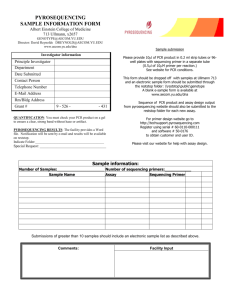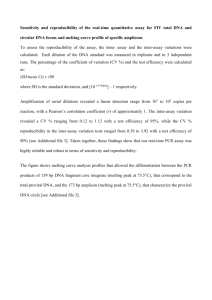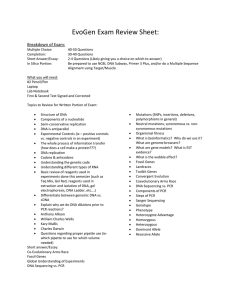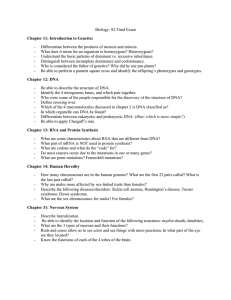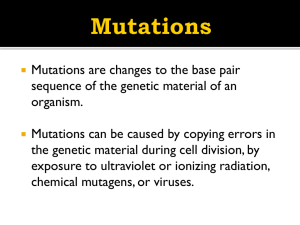Document 13309744
advertisement
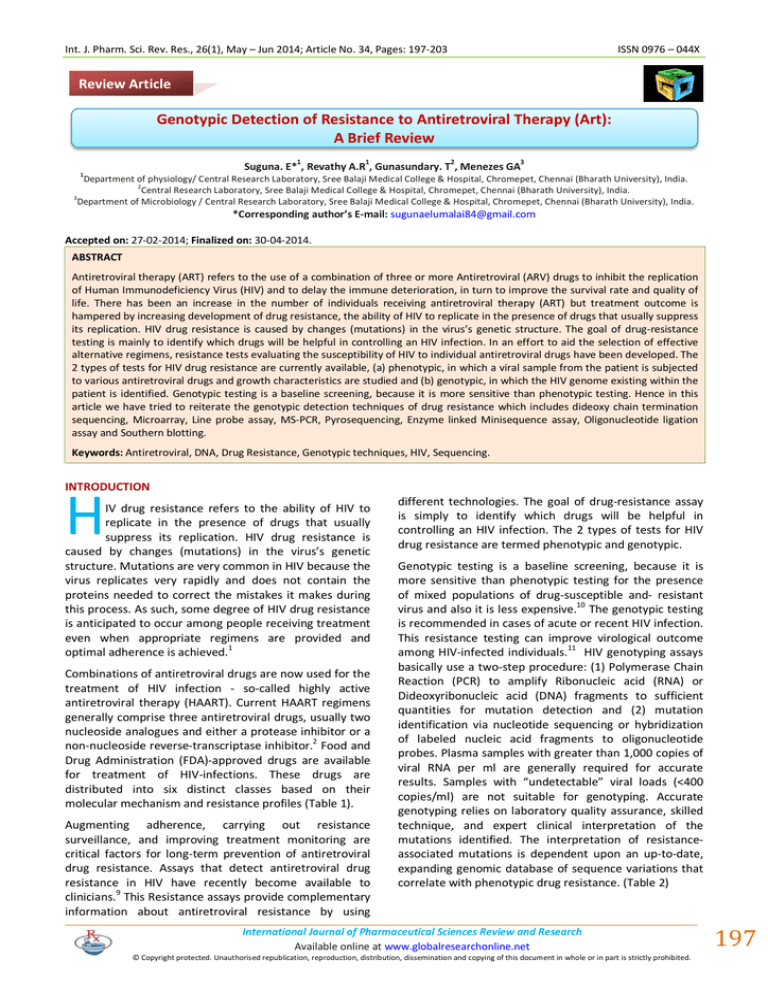
Int. J. Pharm. Sci. Rev. Res., 26(1), May – Jun 2014; Article No. 34, Pages: 197-203 ISSN 0976 – 044X Review Article Genotypic Detection of Resistance to Antiretroviral Therapy (Art): A Brief Review 1 1 2 3 Suguna. E* , Revathy A.R , Gunasundary. T , Menezes GA 1 Department of physiology/ Central Research Laboratory, Sree Balaji Medical College & Hospital, Chromepet, Chennai (Bharath University), India. 2 Central Research Laboratory, Sree Balaji Medical College & Hospital, Chromepet, Chennai (Bharath University), India. 3 Department of Microbiology / Central Research Laboratory, Sree Balaji Medical College & Hospital, Chromepet, Chennai (Bharath University), India. *Corresponding author’s E-mail: sugunaelumalai84@gmail.com Accepted on: 27-02-2014; Finalized on: 30-04-2014. ABSTRACT Antiretroviral therapy (ART) refers to the use of a combination of three or more Antiretroviral (ARV) drugs to inhibit the replication of Human Immunodeficiency Virus (HIV) and to delay the immune deterioration, in turn to improve the survival rate and quality of life. There has been an increase in the number of individuals receiving antiretroviral therapy (ART) but treatment outcome is hampered by increasing development of drug resistance, the ability of HIV to replicate in the presence of drugs that usually suppress its replication. HIV drug resistance is caused by changes (mutations) in the virus’s genetic structure. The goal of drug-resistance testing is mainly to identify which drugs will be helpful in controlling an HIV infection. In an effort to aid the selection of effective alternative regimens, resistance tests evaluating the susceptibility of HIV to individual antiretroviral drugs have been developed. The 2 types of tests for HIV drug resistance are currently available, (a) phenotypic, in which a viral sample from the patient is subjected to various antiretroviral drugs and growth characteristics are studied and (b) genotypic, in which the HIV genome existing within the patient is identified. Genotypic testing is a baseline screening, because it is more sensitive than phenotypic testing. Hence in this article we have tried to reiterate the genotypic detection techniques of drug resistance which includes dideoxy chain termination sequencing, Microarray, Line probe assay, MS-PCR, Pyrosequencing, Enzyme linked Minisequence assay, Oligonucleotide ligation assay and Southern blotting. Keywords: Antiretroviral, DNA, Drug Resistance, Genotypic techniques, HIV, Sequencing. INTRODUCTION H IV drug resistance refers to the ability of HIV to replicate in the presence of drugs that usually suppress its replication. HIV drug resistance is caused by changes (mutations) in the virus’s genetic structure. Mutations are very common in HIV because the virus replicates very rapidly and does not contain the proteins needed to correct the mistakes it makes during this process. As such, some degree of HIV drug resistance is anticipated to occur among people receiving treatment even when appropriate regimens are provided and optimal adherence is achieved.1 Combinations of antiretroviral drugs are now used for the treatment of HIV infection - so-called highly active antiretroviral therapy (HAART). Current HAART regimens generally comprise three antiretroviral drugs, usually two nucleoside analogues and either a protease inhibitor or a 2 non-nucleoside reverse-transcriptase inhibitor. Food and Drug Administration (FDA)-approved drugs are available for treatment of HIV-infections. These drugs are distributed into six distinct classes based on their molecular mechanism and resistance profiles (Table 1). Augmenting adherence, carrying out resistance surveillance, and improving treatment monitoring are critical factors for long-term prevention of antiretroviral drug resistance. Assays that detect antiretroviral drug resistance in HIV have recently become available to clinicians.9 This Resistance assays provide complementary information about antiretroviral resistance by using different technologies. The goal of drug-resistance assay is simply to identify which drugs will be helpful in controlling an HIV infection. The 2 types of tests for HIV drug resistance are termed phenotypic and genotypic. Genotypic testing is a baseline screening, because it is more sensitive than phenotypic testing for the presence of mixed populations of drug-susceptible and- resistant 10 virus and also it is less expensive. The genotypic testing is recommended in cases of acute or recent HIV infection. This resistance testing can improve virological outcome among HIV-infected individuals.11 HIV genotyping assays basically use a two-step procedure: (1) Polymerase Chain Reaction (PCR) to amplify Ribonucleic acid (RNA) or Dideoxyribonucleic acid (DNA) fragments to sufficient quantities for mutation detection and (2) mutation identification via nucleotide sequencing or hybridization of labeled nucleic acid fragments to oligonucleotide probes. Plasma samples with greater than 1,000 copies of viral RNA per ml are generally required for accurate results. Samples with “undetectable” viral loads (<400 copies/ml) are not suitable for genotyping. Accurate genotyping relies on laboratory quality assurance, skilled technique, and expert clinical interpretation of the mutations identified. The interpretation of resistanceassociated mutations is dependent upon an up-to-date, expanding genomic database of sequence variations that correlate with phenotypic drug resistance. (Table 2) International Journal of Pharmaceutical Sciences Review and Research Available online at www.globalresearchonline.net © Copyright protected. Unauthorised republication, reproduction, distribution, dissemination and copying of this document in whole or in part is strictly prohibited. 197 Int. J. Pharm. Sci. Rev. Res., 26(1), May – Jun 2014; Article No. 34, Pages: 197-203 ISSN 0976 – 044X Table 1: FDA approved drugs for treatment of HIV infections Class of drugs Name of the drugs Reference Nucleoside/Nucleotide Reverse Transcriptase Inhibitors (Nnrtis). Abacavir (ABC, Ziagen), Didanosine (Ddi, Videx), Emtricitabine (FTC,Emtriva), Lamivudine (3TC, Epivir), Stavudine(D4t, Zerit), Zalcitabine (Ddc, Hivid), Zidovudine (AZT, Retrovir), And Tenofovir Disoprovil Fumarate (TDF, Viread) Young FE. et al.,1988 Non–Nucleoside Reverse Transcriptase Inhibitors (Nnrtis). Etravirine, Delavirdine, Efavirenz, and Nevirapine Kohlstaedt LA 4 et al., 1992 Integrase Inhibitors. Raltegravir (RAL), MK-0518 Espeseth AS et al., 2000 Protease Inhibitors (Pis). Amprenavir (Apv, Agenerase), Atazanavir (Atz, Reyataz), Darunavir (Tmc114, Prezista), Fosamprenavir (Lexiva), Indinavir (Idv,Crixivan), Lopinavir (Lpv), Nelfinavir (Nfv, Viracept), Ritonavir (Rtv, Norvir), Saquinavir (Sqv, Fortovase/ Invirase), And Tipranavir (Tpv, Aptivus) Park J, et al.,1993 Fusion Inhibitors. Fuzeon Wilen CB et al., 2011 Co Receptor Antagonists. Selzentry Dragic T et al., 2000 3 5 6 7 8 Table 2: List of drug-resistance mutations identified within the HIV-1 Protease and RT Genes using genotypic detection techniques Detection techniques HIV gene Drug resistance Mutation Identified Reference Microarray (GENECHIP) RT Zidovudine Codon 65 Mellors, J. W. 1998 Pyrosequencing POL Protease inhibitors (PI) - O’Meara et al., 2001 Line Probe Assay RT AZT, ddI, ddC, and 3TC 69,70,74 And 215. Stuyver, L et al., 1997 Enzyme Linked Minisequence Assay RT and POL (1)Nucleoside analogue resistance & (2) protease inhibitor resistance (1)Codon41, 67, 70,215, 184 & (2)30,46,48,82,84, 90 Wataru Sugiura et al, 2003 Point Mutation Assay(Or) Ms-Pcr RT Zidovudine (1)41 and70 (2)41, 67, 70, 215, 210,219 Lay Myint et al., 2002 17 Harrigan, P et al., 1996 Codon 215 Reva E.Edelstein -1997 Robert W. Shafer et al.,19 1996 - P. Scott Eastman et al., 20 1995 12 13 14 15 16 18 Oligonucleotide Ligation Assay POL and RT Zidovudine, didanosine, and lamivudine. Southern Blotting RT Zidovudine Genotyping Detection Technique Dideoxynucleotide terminator cycle sequencing DNA sequencing is one of the most important platforms for the study of biological systems today. Sequence determination is most commonly performed using dideoxy chain termination technology. The chain termination sequencing method, also known as Sanger sequencing, was developed by Frederick Sanger and colleagues21, has been the most widely used sequencing method since its advent in 1977 and still is in use after more than 29 years. The dideoxy method gets its name from the critical role played by synthetic nucleotides that lack the -OH at the 3′ carbon atom. A dideoxynucleotide (dideoxy thymidine triphosphate ddTTP) can be added to the growing DNA strand but when it is, chain elongation stops because there is no 3′ -OH for the next nucleotide to be attached. For this reason, the dideoxy method is 21 also called the chain termination method. Most commercially available genotypic tests rely on automated sequencing technology. Viral RNA is extracted from plasma sample and reverse transcribed into complementary DNA (cDNA). The Protease (PR or POL) and Reverse transcriptase (RT) coding regions of the cDNA are then amplified by polymerase chain reaction (PCR), and the nucleotide sequence of the PCR product (or amplicons) is determined on an automated DNA sequence. (Figure 1) The sequencing assays may lead to a useful clinical niche with further development which could be cheaper and faster to detect minority subpopulations (to 10% or less). International Journal of Pharmaceutical Sciences Review and Research Available online at www.globalresearchonline.net © Copyright protected. Unauthorised republication, reproduction, distribution, dissemination and copying of this document in whole or in part is strictly prohibited. 198 Int. J. Pharm. Sci. Rev. Res., 26(1), May – Jun 2014; Article No. 34, Pages: 197-203 ISSN 0976 – 044X been associated with zidovudine resistance mutations.12 The following fields are mainly involved for microarray application; cancer , toxicology, cardiology, nutrition & aging, bacteriology, and mycology have all benefited from 22-27 this technology. Line probe assay Figure 1: Schematic representation of Dideoxy chain termination sequencing Sequencing by hybridization (or) High density nucleotide arrays (Microarray) One powerful technology which is becoming increasingly useful in the analysis of viral infections is that of DNA microarray (Gene chip) technology. In this method, a high density DNA array is generated, comprising millions of different oligonucleotides spotted onto a solid support. Biotinylated labeled DNA sample is then added to the microarray, and allowed to anneal. After extensive washing, the bound sample DNA is detected using a fluorescent probe (streptavidin-phycoerythrin). Arrays are scanned with scanners that read the intensity of the fluorescent signal at different positions on the chip and data analysis by computer. (Figure 2) To begin with, HIV RNA preparation, cDNA synthesis, and PCR with biotinylated primers are performed. Biotinylated DNA is hybridized with specific oligonucleotide probes immobilized in parallel lines on membrane-based strips. After hybridization, streptavidin labeled with alkaline phosphatase is added and binds to biotinylated hybrids. Incubation with a chromogen results in a purple-brown precipitate visible to the naked eye. The locations of these colored bands on the strip determine the presence of specific wild-type codons, mixtures of codons, and 14 mutant codons. Line probe assay (LiPA) for the rapid and simultaneous characterization of the following variations in the RT gene: M41 or L41; T69, N69, A69, or D69; K70 or R70; L74 or V74; V75 or T75; M184, I184, or V184; T215, Y215, or F215; and K219, Q219, or E219. Detection of the wildtype RT gene and selected mutations associated with genotypic resistance to Zidovudine (AZT), Didanosine (ddI), Zalcitabine (ddC), and Lamivudine (3TC). LiPA is suitable for detecting mixed populations and easy to implement in clinical laboratories and might be useful for epidemiological surveys of primary HIV-1 resistance.28 Point mutation assays (or) Mutagenic ally separated PCR (MS-PCR) The principle of mutagenic ally separated PCR (MS-PCR), first developed by Rust et al., can be applied to the HIV-1 nonnucleoside analogue reverse transcriptase (RT) and protease inhibitor-resistant mutation detection.29, 30 The MS-PCR assay is a rapid, simple, and inexpensive assay that is highly sensitive in detecting mutant targets, including minor populations. Thus, it could be used as a powerful tool for epidemiological surveillance of drugresistant mutations in developing countries. Figure 2: Schematic representation of Microarray (GeneChip) DNA microarray can be used for specific point mutations in the human genome (e.g., disease associated mutations, specific mutations associated with resistance to antiviral drugs and mutations associated with enhanced susceptibility to certain viral infections) and it is also capable of detecting specific individual gene transcripts and splice variants and can even differentiate among closely related members of gene families. Mellors, J. W. in 1998 studied the detection of length polymorphism sequence at codon 69 of RT region has Viral RNA is extracted from patient plasma and one-step RT-PCR with mutagenically separated primer pair and PCR for targeted sequence is performed. Two competitive detection primers are required for each detection point. One is for wild-type detection and the other is for mutant detection and there are three basic rules for the primer design: the 3′ end of each detection primer is designed to correspond to the wild-type or the mutant nucleotide pattern; to distinguish wild-type and mutant amplicons on electrophoresis, wild-type detection primers must be 20 bp longer than the mutant primers.16 MS-PCR is sensitive and specific for the detection of mutations in HIV-1, and can be adapted easily to test for resistance at any codon of interest. A rapid zidovudine (ZDV) resistance genotypic assay was developed based on the mutagenically separated PCR (MS-PCR) technique to International Journal of Pharmaceutical Sciences Review and Research Available online at www.globalresearchonline.net © Copyright protected. Unauthorised republication, reproduction, distribution, dissemination and copying of this document in whole or in part is strictly prohibited. 199 Int. J. Pharm. Sci. Rev. Res., 26(1), May – Jun 2014; Article No. 34, Pages: 197-203 detect two ZDV-resistant mutations, M41L and K70R in 16 CRF01_AE (subtype E) and also M41L, D67R, K70R, T215F/Y, L210W, and K219Q mutations are known to be associated with ZDV resistance in subtype B isolates.17 Pyrosequencing Pyrosequencing is a novel DNA sequencing technology, developed at the Royal Institute of Technology, and it is the first alternative to the conventional Sanger method for de novo DNA sequencing. This method relies on the luminometric detection of pyrophosphate that is released during primer-directed DNA polymerase catalyzed nucleotide incorporation.31 This technique is a widely applicable, alternative approach for the detailed characterization of nucleic acids. Pyrosequencing has potential advantages of accuracy, flexibility, parallel processing, and can be easily automated. Furthermore, the technique avoids the need for labeled primers, labeled nucleotides, and gel electrophoresis. Pyrosequencing has been successful for both confirmatory sequencing and denovo sequencing.32 It employs a series of four enzymes to accurately detect nucleic acid sequences during the synthesis. In Pyrosequencing the sequencing primer is hybridized to a single-stranded DNA biotin-labeled template and mixed with the enzymes; DNA polymerase, ATP sulfurylase, Luciferase and Apyrase, and the substrates adenosine 5phosphosulfate (APS) and luciferin.33 (Figure 3) Figure 3: Diagrammatic representation of Pyrosequencing In Pyrosequencing nucleotide removal is performed in two different ways: (i) the solid phase pyrosequencing, which utilizes a three coupled enzymatic procedure with washing steps and (ii) the liquid-phase pyrosequencing technique, which employs a cascade of four enzymes with no washing steps.34 Solid phase Pyrosequencing The biotin labeled DNA template with annealed primer is immobilized to streptavidin coated magnetic beads.35 The immobilized, primed single-stranded DNA is incubated with three enzymes: DNA polymerase, ATP sulfurylase and luciferase. After each nucleotide addition to the reaction mixture, the DNA template is immobilized by a ISSN 0976 – 044X magnet system and the unincorporated nucleotides are removed by a washing step. Liquid phase Pyrosequencing Pyrosequencing by the liquid-phase approach came about by the introduction of a nucleotide-degrading enzyme, 15, 36 called apyrase. The implementation of this enzyme in the Pyrosequencing system excluded the use of solidphase separation, and consequently, eliminated extra steps such as washes and repetitive enzyme additions. Apyrase shows high catalytic activity and low amounts of this enzyme in the reaction system efficiently degrade the unincorporated nucleoside triphosphate to nucleoside diphosphate and subsequently to nucleoside monophosphate. In addition, apyrase stabilizes the baseline with no fluctuations in the sequencing procedure.20 Enzyme-Linked Minisequence Assay Enzyme linked mini-sequence assay (ELMA) mainly used for monitoring drug resistance in the developing countries. In addition ELMA detects minor resistant populations (10%) by the assay. The high sensitivity and specificity of the assay mainly recommend it as a first screening assay for drug resistance surveillance. In ELMA, two modifications to the standard hybridization method were introduced. First, a relatively low annealing temperature was selected for the hybridization reaction. For this low temperature minimized the effect of unexpected mutations within the target sequence and decreased the risk of false-negative results. Second, a 1base extension reaction of the probe with tagged deoxynucleotide was added after the hybridization step. The assay consists of four major steps: (i) extraction and amplification, (ii) hybridization, (iii) extension, and (iv) visualization. In the first step, extraction and amplification, target DNA fragments with one or more detection points are amplified from patient plasma viral RNA. In the second step, hybridization, the denatured amplified target DNA fragments are captured by the corresponding oligonucleotide probe applied to an enzyme-linked immunosorbent assay (ELISA) plate. The third step is an extension step. A biotinylated dNTP is incorporated on the 3′ end of each oligonucleotide probe. The final step is visualization, in which the incorporated biotinylated dNTP is visualized by using horseradish peroxidase (HRP)-conjugated avidin and HRP as substrates.37 The basic technology of ELMA is a combination of DNA hybridization and point mutation detection by 1-base elongation with a biotinylated deoxynucleotide, i.e., a minisequence.26 This assay detects five mutations conferring nucleoside analogue resistance (M41L, D67N, K70R, T215Y, and M184V) and six mutations conferring protease inhibitor resistance (D30N, M46I, G48V, V82A, I84V, and L90M). International Journal of Pharmaceutical Sciences Review and Research Available online at www.globalresearchonline.net © Copyright protected. Unauthorised republication, reproduction, distribution, dissemination and copying of this document in whole or in part is strictly prohibited. 200 Int. J. Pharm. Sci. Rev. Res., 26(1), May – Jun 2014; Article No. 34, Pages: 197-203 Oligonucleotide ligation assay Oligonucleotide ligation assay (OLA) is a rapid, sensitive, and specific method for the detection of known single nucleotide polymorphisms (SNPs). Ligation assays have a number of advantages in genotyping mutations within the HIV pol gene compared to other phenotypic or genotypic approaches.38,18 First, because of their highly specific nature, ligation assays yield clear positive or negative outcomes that are easy to interpret visually or that can be interpreted by a spectrophotometer and computer program with samples on a micro titer plate. RNA was obtained by silica extraction of plasma or cerebrospinal fluid with the QIAmp Viral RNA kit (QIAGEN) and cDNA was synthesized by using SuperScript II RNase H reverse transcriptase. The cDNA was amplified by nested PCR and followed by ligation. This method is based on the joining of two adjacent oligonucleotide probes (Capture and Reporter Oligos) using a DNA ligase while they are annealed to a complementary DNA target (e.g. PCR product). These capture and reporter oligo probes differ only in sequence at the last base at the 3' end. The reporter probe is a common probe that is complementary to the target DNA sequence immediately downstream (3') of the SNP site. This probe is modified with a phosphate at its 5' end, and has no fluorescent modification. Allele discrimination occurs by the ability of DNA ligase to join perfectly matched probes; a 3' mismatch in the capture probe will prevent ligation.39 Robert W. Shafer et al., 1996 studied the sequencespecific PCR used in six laboratories and a ligase detection reaction used in one laboratory to detect the Zidovudineresistance mutation at codon 215 of human immunodeficiency virus type 1 (HIV-1) reverse transcriptase DNA.19 Reva E. Edelstein in 1997 studied the detection of mutations in the pol gene of human immunodeficiency virus type 1 associated with resistance to Zidovudine, didanosine, and by genotyping by an oligonucleotide ligation assay specific codons in the pol gene amplified by PCR and also is ideally suited for typing point mutations in the human immunodeficiency virus type 1 (HIV-1) genome, including their specificity, sensitivity, and compatibility with DNA amplification by PCR.18 Southern blotting ISSN 0976 – 044X The transfer of DNA to a solid membrane support and detection of virus-specific sequences using radiolabeled viral nucleic acids was described by P. Scott Eastman in 1995. In this hybridization assay, he determined the HIV genotypic Zidovudine resistance. Biotinylated PCR product was hybridized with enzyme-labeled probes for wild-type or resistant mutant sequences and detected calorimetrically or chemiluminescently in a micro plate format. Changes in mutant-to-wild-type ratios allow the monitoring of longitudinal patient samples.20 Figure 4: Diagrammatic representation of Southern Blotting CONCLUSION In the past few years the selection of a combination regimen continues to be challenging because of increasing development of drug resistance. Nevertheless, the number of available antiretroviral agents has markedly increased. Genotyping assays that detect antiretroviral drug resistance in HIV have recently become available to clinicians, which is based on determination of the nucleotide sequence of regions that confer phenotypic resistance and it determines the presence of mutations that are known to confer decreased drug susceptibility. Hence we suggest that genotyping resistance testing may be useful in the assessment of the success of salvage antiretroviral therapy and may improve short-term virological response when compared to other detection testing. We also state that the genotyping resistance testing is recommended to help guide the choice of new drugs for pregnant women and also for the patients non-responsive to treatment. REFERENCES Southern hybridization assay was developed by Southern (1975) involving restriction enzyme digestion and agarose gel electrophoresis of the target DNA prior to hybridization. The different bands on the agarose gel are transferred by capillary action onto a nitrocellulose or nylon membrane in a blotting apparatus. During the transfer, each of the DNA bands is transferred onto the membrane in the same relative position that it had in the gel. After the transfer, the target DNA is probed and detected by autoradiography. (Figure 4) The main drawback with this membrane is its fragile nature. 1. Richman DD, Morton SC, Wrin T, Hellmann N, Berry S, Shapiro MF, Bozzette SA, The prevalence of antiretroviral drug resistance in the United States, AIDS, 18, 2004, 1393– 1401. 2. Yeni PG, Hammer SM, Carpenter CC, Cooper DA, Fischl MA, Gatell JM, Gazzard BG, Hirsch MS, Jacobsen DM, Katzenstein DA, Montaner JS, Richman DD, Saag MS, Schechter M, Schooley RT, Thompson MA, Vella S, Volberding PA, Antiretroviral treatment for adult HIV infection in 2002: updated recommendations of the International Journal of Pharmaceutical Sciences Review and Research Available online at www.globalresearchonline.net © Copyright protected. Unauthorised republication, reproduction, distribution, dissemination and copying of this document in whole or in part is strictly prohibited. 201 Int. J. Pharm. Sci. Rev. Res., 26(1), May – Jun 2014; Article No. 34, Pages: 197-203 International AIDS Society-USA Panel, JAMA, 288, 2002, 222-235. 3. Young FE, The role of the FDA in the effort against AIDS, Public Health Rep, 103, 1988, 242–245. 4. Kohlstaedt LA, Wang J, Friedman JM, Rice PA, Steitz TA, Crystal structures at 3.5 A resolution of HIV-1 reverse transcriptase complexed with an inhibitor, Science, 256, 1992, 1783–1790. 5. Amy S. Espeseth, Peter Felock, Daria J. Hazuda, HIV-1 integrase inhibitors that compete with the target DNA substrate define a unique strand transfer conformation for integrase, Proc Natl Acad Sci, 97, 2000, 11244–11249. 6. Park J, Morrow CD, Mutations in the protease gene of human immunodeficiency virus type 1 affect release and stability of virus particles, Virology, 194, 1993, 843–850. ISSN 0976 – 044X 16. Lay Myint, Koya Ariyoshi, Hua Yan, Alexander J. Frater, Wattana Auwanit, Panita Pathipvanith, Kaneo Yamada, Masakazu Matsuda, Tomoko Chiba, Kazunori Fujita, Myra McClure, Jonathan N. Weber, Wataru Sugiura, Mutagenically Separated PCR Assay for Rapid Detection of M41L and K70R Zidovudine Resistance Mutations in CRF01_AE (Subtype E) Human Immunodeficiency Virus Type 1, antimicrobial agents and chemotherapy, 46, 2002, 3861–3868. 17. Harrigan PR, I. Kinghorn, S. Bloor, SD Kemp, I.Najera, A.Kohli, B.A.Larder, Significance of amino acid variation at human immunodeficiency virus type 1 reverse transcriptase residue 210 for zidovudine susceptibility, J. Virol, 70, 1996, 593–594. 18. Reva E. Edelstein, Deborah A. Nickerson, Vincent O. Tobe, Laura A. Manns-Arcuino, Lisa M. Frenkel, Oligonucleotide Ligation Assay for Detecting Mutations in the Human Immunodeficiency Virus Type 1 pol Gene That Are Associated with Resistance to Zidovudine, Didanosine, and Lamivudine, Journal of clinical microbiology, 1998, 569– 572. 7. Wilen CB, Tilton JC, Doms RW, HIV: Cell binding and entry, Cold Spring Harb Perspect Med doi, 10.1101, 2011, cshperspect.a006866. 8. Tatjana Dragic, Alexandra Trkola, Thompson DA, John P, Moore, A binding pocket for a small molecule inhibitor of HIV-1 entry within the transmembrane helices of CCR5, Proc Natl Acad Sci, 97, 2000, 5639–5644. 19. Kenneth H. Mayer, George J. Hanna, Richard T. D'Aquila, Clinical Use of Genotypic and Phenotypic Drug Resistance Testing to Monitor Antiretroviral Chemotherapy, Clin Infect Dis, 32, 2001, 774-782. Robert W.Shafer, Mark A. Winters, Robert M.Jellinger, Thomas C.Merigan, Robert W. Shafer, Center for AIDS Research, The Journal of Infectious Diseases, 174, 1996, 448-449. 20. P. Scott Eastman, Eric boyer, Larry mole, Janice Kolberg, Mickey Urdea, Mark Holodniy, Nonisotopic Hybridization Assay For Determination Of Relative Amounts Of Genotypic Human Immunodeficiency Virus Type 1 Zidovudine Resistance, Journal of clinical microbiology, 1995, 2777– 2780. 21. Sanger F, Nicklen S, Coulson AR, DNA sequencing with chain-terminating inhibitors, Proc. Natl. Acad. Sci. USA, 74, 1977, 5463-5467. 22. Virtaneva K , Wright FA, Tanner SM, Yuan B, Lemon WJ, Caligiuri MA, Bloomfield CD, de La Chapelle A, Krahe R, Expression profiling reveals fundamental biological differences in acute myeloid leukemia with isolated trisomy 8 and normal Cytogenetics, PNAS, 98, 2001, 1124–1129. 23. Gerhold D, Lu M, Xu J, Austin C, Caskey CT, Rushmore T, Monitoring expression of genes involved in drug metabolism and toxicology using DNA microarrays, Physiol Genomics, 5, 2001, 161–170. 24. Hongkui Jin, Renhui Yang, Tarif A. Awad, Fay Wang, Wei Li, Simon-Peter Williams, Annie Ogasawara, Brian Shimada, P. Mickey Williams, Gianfranco de Feo, Nicholas F. Paoni, Effects of early angiotensin-converting enzyme inhibition on cardiac gene expression after acute myocardial infarction, Circulation, 103, 2001, 737–742. 25. Jiang CH, Tsien JZ, Schult PG, Hu Y, The effects of aging on gene expression in the hypothalamus and cortex of mice, PNAS, 98, 2001, 1930–1934. 26. Hooper LV, Wong MH, Thelin A, Hansson L, Falk PG, Gordon JI, Molecular analysis of commensal host-microbial relationships in the intestine, Science, 291, 2001, 881–884. 27. Scott A. Jelinsky, Preston Estep, George M. Church, and Leona D. Samson, Regulatory networks revealed by transcriptional profiling of damaged Saccharomyces 9. 10. 11. Joel E. Gallant, Shruti H. Mehta, Jeremy Sugarman, Universal Antiretroviral Therapy for HIV Infection: Should U.S. Treatment Guidelines Be Applied to Resource‐Limited Settings, Clinical Infectious Diseases Advance Access published, June 11, 2013. Martin S. Hirsch, Huldrych F. Günthard, Jonathan M. Schapiro, Françoise Brun Vézinet, Bonaventura Clotet, Scott M. Hammer, Victoria A. Johnson, Daniel R. Kuritzkes, John W. Mellors, Deenan Pillay, Patrick G. Yeni, Donna M. Jacobsen, Douglas D. Richman, Antiretroviral Drug Resistance Testing in Adult HIV-1 Infection: 2008 Recommendations of an International AIDS Society–USA Panel, Clinical Infectious Diseases, 47, 2008, 266–285. 12. Mellors, JW, Review of Lago Maggiore resistance meeting, th 12 World AIDS Conference, Geneva, Switzerland, 1998. 13. Deirdre O'Meara, Karin Wilbe, and Joakim Lundeberg, Monitoring resistance to human immunodeficiency virus type 1 protease inhibitors by Pyrosequencing, J. Clin. Microbiol, 39, 2001, 464–473. 14. Lieven stuyver, ann wyseur, annelies rombout, joost louwagie,Thierry scarcez, chris verhofstede, david rimland, Raymond f. Schinazi, and rudi rossau, Line probe assay for rapid detection of drug-selected mutations in the human immunodeficiency virus type 1 reverse transcriptase gene, antimicrobial agents chemotherapy, 41, 1977, 284–291. 15. Wataru Sugiura, Kazunori Shimada, Masakazu Matsuda, Tomoko Chiba, Lay Myint, Aiko Okano, Kaneo Yamada, Novel Enzyme-Linked Minisequence Assay for Genotypic Analysis of Human Immunodeficiency Virus Type 1 Drug Resistance, Journal of clinical microbiology, 41, 2003, 4971–4979. 1 International Journal of Pharmaceutical Sciences Review and Research Available online at www.globalresearchonline.net © Copyright protected. Unauthorised republication, reproduction, distribution, dissemination and copying of this document in whole or in part is strictly prohibited. 202 Int. J. Pharm. Sci. Rev. Res., 26(1), May – Jun 2014; Article No. 34, Pages: 197-203 cerevisiae cells: Rpn4 links base excision repair with proteasomes, Mol Cell Biol, 20, 2000, 8157–8167. 28. Diane descamps, vincent calvez, gilles collin, agnescecille, cristian apetrei, florence damond, christine katlama, sophie matheron, jean-marie huraux, andfrancoise brun-vezinet, line probe assay for detection of human immunodeficiency virus type 1 mutations conferring resistance to nucleoside inhibitors of reverse transcriptase: comparison with sequence analysis, journal of clinical microbiology, 36, 1998, 2143–2145. 29. Rust SH, Funke, G. Assmann, Mutagenically separated PCR (MS-PCR): a high specific one step procedure for easy mutation detection, Nucleic Acids Res, 21, 1993, 3623– 3629. 30. Frater AJ, Chaput CC, Beddows S, Weber JN, McClure MO, Simple detection of point mutations associated with HIV-1 drug resistance, J. Virol. Methods, 93, 2001, 145–156. 31. Gharizadeh B., Ohlin A., Molling P, Backman A, Amini B, Olcen P, Nyren P, Multiple group-specific sequencing primers for reliable and rapid DNA sequencing, Mol. Cell Probes, 17, 2003, 203-210. 32. Ronaghi M, Karamohamed S, Pettersson B, Uhlen M, Nyren P, Real-time DNA sequencing using detection of pyrophosphate release, Anal. Biochem, 242, 1996, 84–89. ISSN 0976 – 044X 33. Gharizadeh B, Ghaderi M, Nyren P, Pyrosequencing technology for short DNA sequencing and whole genome sequencing, Technology, 47, 2007, 129-132. 34. Nyren P, Skarpnack SE, Method of sequencing DNA based on the detection of the release of pyrophosphate and enzymatic nucleotide degradation, U.S. Patent, 2001, 6258568, http://ip.com/patent/US6258568. 35. Ronaghi M, Pyrosequencing sheds light on sequencing, Genome Research, 11, 2001, doi:10.1101/gr.150601. 36. Kobayashi, S, K. Shimada, H. Suzuki, K. Tanikawa, M.Sats, Development of a new method for detecting a mutation in the gene encoding hepatitis B virus reverse transcriptase active site (YMDD motif), Hepatology Res, 17, 2000, 31–42. 37. Boucher CAB, W Keulen, T van Bommel, M Nijuis, D.de Jong, P Schipper, N.K.T.Back, Human immunodeficiency virus type 1 drug susceptibility determination by using recombinant viruses generated from patient sera tested in a cell-killing assay, Antimicrob. Agents Chemother, 40, 1996, 2404–2409. 38. Larder BA, P Kellam, SD Kemp, Zidovudine resistance predicted by direct detection of mutations in DNA from HIV-infected lymphocytes, AIDS, 5, 1999, 137–144. 39. Landegren U, R Kaiser, J Sanders, L.Hood, A ligase-mediated gene detection technique, Science, 241, 1998, 1077–1080. DNA 3-11 Source of Support: Nil, Conflict of Interest: None. International Journal of Pharmaceutical Sciences Review and Research Available online at www.globalresearchonline.net © Copyright protected. Unauthorised republication, reproduction, distribution, dissemination and copying of this document in whole or in part is strictly prohibited. 203
